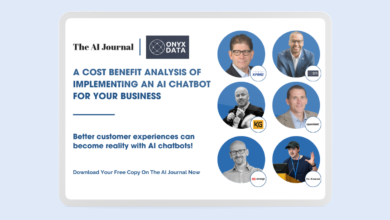
The fast-moving world of business highly depends on efficient helpdesk solutions that guarantee smooth interaction with customers and support internal stakeholders. As businesses realize the significance of their helpdesk platforms to customers’ satisfaction and operating efficiency, artificial intelligence as a concept is seen to revolutionize old support methods.
Data show the increasing relevance of AI for helpdesk systems. Recent findings reveal that 37% of companies have already implemented AI, an impressive rise of 270% within four years. This ever-rising adoption rate indicates how AI can change customer service and employee engagement beyond recognition.
Also, market watchers like Gartner predict a significant move towards AI-driven approaches to handling HR inquiries. Such forecasts show that about 75% of HR department issues can be dealt with most efficiently through chatbots and other conversational artificial intelligence platforms, thus streamlining processes and improving employee experience.
Fusing AI technology with helpdesk solutions is a crucial strategy as companies strive to navigate the complexities of modern business operations and meet the changing needs of customers and employees. This blog post discusses how these helpdesk solutions based on AI can turn around employee engagement, automate various processes, and open new directions for the development of support experiences.
Understanding the Role of Helpdesk Solutions
Modern workplace setups rely heavily on helpdesk solutions, which are vital to managing and resolving customer questions, technical issues, or any other support request. At the core, a helpdesk acts as a communication link for the organization and its customers, thus enhancing amicable interaction and leading to timely resolutions.
One significant role of a helpdesk is offering first-line client support. This entails answering queries about products or services, fixing computer glitches, and guiding users through various processes. By rendering quick and efficient support, help desk solutions lead to satisfied clients, increased loyalty to the company, and enhanced reputation.
Furthermore, helpdesk solutions are a valuable internal resource for stakeholders such as employees and other departments within the firm. Often, workers go to the helpdesk for IT support, software training, and assistance with general workplace technologies. Having a unified source of information and problem-solving in place will allow employees in their respective areas of work to be more productive.
Apart from offering communication channels and helping solve client issues, helpdesk solutions are also helpful in collecting and analyzing data regarding customer interactions. Such information includes queries received, turnaround times, resolution rates, and consumer feedback, hence creating opportunities for improvement based on this insight. Consequently, organizations are adopting data-driven techniques to streamline their helpdesk operations by increasing the quality of support given, leading to better business results by Traditional Helpdesk Systems.
Traditional helpdesk systems have been critical in managing technical issues and employee support operations. Often, these challenges are encountered and act as obstacles to the effectiveness of these traditional tools on organizational productivity. Such challenges include:
Limited Scalability
Traditional helpdesk systems may need help to scale effectively to meet the growing demands of businesses, especially those experiencing rapid expansion or fluctuations in support volume. This limitation can lead to longer response times, increased backlog, and decreased customer satisfaction.
High Operational Costs
Maintaining and operating a traditional helpdesk system can be costly, particularly when considering hardware, software licenses, maintenance, and staffing expenses. These high operational costs can strain the organization’s budget and impact for its ability to invest in other strategic initiatives.
Inefficient Ticket Management
Traditional helpdesk systems often rely on manual processes for ticket management, including ticket assignment, prioritization, and tracking. This manual approach can result in inefficiencies, such as duplicate tickets, resolution delays, and difficulty monitoring ticket status and progress.
Lack of Automation
Many traditional helpdesk systems lack automation capabilities, requiring agents to handle routine tasks manually. This can decrease productivity, as agents spend valuable time on repetitive and mundane activities instead of focusing on more complex and high-value tasks.
Limited Integration
Traditional helpdesk systems may need help integrating seamlessly with other business systems and applications, such as CRM software, project management tools, and knowledge bases. This lack of integration can hinder information sharing, collaboration, and efficiency across departments and functions.
Insufficient Data Analysis
While traditional helpdesk systems capture data related to customer interactions and support tickets, they often need robust analytics capabilities to extract actionable insights from this data. With meaningful analysis, organizations may be able to identify trends, optimize processes, and improve the overall quality of support.
Inadequate Personalization
Traditional helpdesk systems may need help to deliver personalized support experiences tailored to individual customers’ unique needs and preferences. This lack of personalization can result in generic responses, reduced customer satisfaction, and missed opportunities to build stronger customer relationships.
Addressing these challenges requires organizations to modernize their helpdesk systems by adopting innovative technologies, such as artificial intelligence (AI), automation, and advanced analytics. By overcoming these challenges, organizations can enhance their helpdesk operations’ efficiency, effectiveness, and impact, ultimately driving better business outcomes and customer experiences.
The Emergence of AI in Helpdesk Solutions
Artificial Intelligence (AI) is the term used to refer to a branch of computer science that concerns itself with creating systems capable of carrying out tasks requiring human-like intelligence. In AI for helpdesk solutions, various technologies and techniques are used to automate and improve employee support processes. Natural Language Processing (NLP), Machine Learning (ML), chatbots, and virtual assistants are common types of AI used in helpdesk solutions.
AI has been incorporated into the organizations’ help desk systems across various industries for enhanced effectiveness and improved client contentment levels. Using such technologies as Natural Language Processing (NLP) or Machine Learning (ML), these AI-driven systems offer automated support services and streamline the support process. This makes it possible to handle customer inquiries on time, predict their needs, and deliver personalized experiences, leading to better service quality.
Key Features and Capabilities of AI in Helpdesk Solutions
Natural Language Processing (NLP)
NLP allows helpdesk systems to comprehend and construe human language, thus enhancing communication between customers and support agents. On the other hand, NLP enhances customer interactions by analyzing customer queries, generating accurate responses, and reducing resolution times.
Machine Learning (ML)
ML algorithms empower helpdesk solutions to learn from past interactions and data, improving performance over time. Additionally, this can go a long way towards automating routine tasks such as identifying patterns in customer behavior and support tickets, prioritizing inquiries, and providing predictive insights, thereby ensuring efficiency and customer satisfaction.
Chatbots and Virtual Assistants
AI-driven chatbots serve as frontline support by providing immediate help to customers. These bots offer personalized experiences while reducing human agents’ workload by performing various functions like giving information or troubleshooting issues. They are available 24/7 so that customers get consistent and timely assistance.
Benefits of AI-Powered Helpdesk Solutions
Helpdesk systems powered by artificial intelligence (AI) have many advantages. They resolve the limitations of conventional methods, effectively boosting employee output, client gratification, and organizational performance.
Repetitive Tasks are Automated
AI-powered helpdesk solutions automate repetitive tasks that can weigh down employees, leading to lower productivity. By answering routine inquiries, ticket routing, and basic issue resolution, humans are left with more complex and high-value tasks, boosting efficiency overall.
Employee Productivity is Boosted
AI helpdesk solutions’ automation capabilities significantly increase employee productivity by reducing the time they spend on manual tasks. With AI handling monotonous inquiries and procedural operations, staff can channel their time and expertise to more strategic activities, thereby increasing outputs while improving resource utilization.
Enhanced Revenue Generation
Improved earnings can be derived from this by improving support operations and increasing employee productivity. This will allow employees to concentrate on revenue-generating activities such as sales, customer acquisition, and product innovation instead of being bogged down by repetitive tasks, ultimately leading to business growth.
Better Employee Satisfaction
AI-powered helpdesk solutions result in faster response times, more accurate resolutions, and personalized support experiences, which increase customer satisfaction levels. By using predictive analytics and Artificial Intelligence technologies such as Natural Language Processing (NLP), businesses can provide timely and relevant aid, thereby building stronger relationships with customers for loyalty purposes.
Timesaving and Efficiency Gains
The data shows that 60.5% of respondents answered that AI would be used in employee experience because present-day helpdesk setups take too long, leading to low productivity and revenue loss. Time saving and efficiency gains for both employees and customers are achieved through reduced response times and resolution rates by using artificial intelligence-based helpdesk solutions.
Scalability and Flexibility
Being highly scalable, AI-based helpdesk applications can adjust to fit varying business requirements or support volumes. The organization develops with time; AI can grow seamlessly to meet the increased need for support while continuously maintaining quality of service.
Leveraging AI for Employee Empowerment
Streamlining Routine Tasks
Using AI-powered tools to automate repetitive, mundane tasks allows employees to divert from manual labor to strategic thinking and creativity. This process frees up time that could be spent creating solutions for problems that require critical thinking and problem-solving skills, hence encouraging employees to improve productivity.
Personalized Learning and Development
These learning platforms depend on AI, which uses information about employees’ attributes, such as skills, interests, or preferences, to provide personalized development experiences. By tailoring training experiences according to human needs alone, AI allows for an individual’s pace of skill acquisition, hence promoting continual growth and professionalism.
Augmented Decision-Making
Data-driven decision-making has been one of the significant developments in recent years. AI technologies like machine learning and natural language processing analyze vast amounts of data to provide insights, recommendations, and support for decision-making. When using AI-generated insights, employees can make more informed decisions based on facts, leading to better results and improved business performance.
Collaboration And Communication Improve With AI
AI-powered collaboration tools allow accessible communication and collaboration between employees from anywhere in the world at any time. Such tools facilitate sharing information, ideas, and feedback with colleagues in real time, promoting an organization’s culture of cooperation and innovation.
Optimizing Workforce Efficiency
AI algorithms analyze workforce data to identify trends or patterns relating to employee performance, engagement, and well-being. Organizations can leverage these findings to optimize their workforce management strategies, such as scheduling workload distribution or talent retention, ensuring that they maximize efficiency while keeping their staff happy in the process.
Empowering Remote Work
Due to the increase in the popularity of remote work, AI Technology has become an integral part of making it possible for employees to be effective anywhere. This is made possible through AI-powered tools that support virtual meetings and teamwork and coordinate project management, thereby availing them of the necessary resources and support required for their well-being in a distributed work setting.
Continuous Feedback and Improvement
Employees can track their performance using AI-initiated performance systems, which offer feedback in real-time and evaluate performances. This continuous loop for employees leads to a learning and growth culture where they are empowered to maximize their potential and bring out their best, which makes the organization succeed.
Closing Note
The combination of AI in next-gen helpdesk platforms means a revolution in employee empowerment is underway. This will eventually see organizations automate support functions using AI-driven tools such as predictive analytics and natural language processing to speed up their processes and make them more efficient, making life better for the workers. To this end, not only does it improve productivity and happiness among employees, but it also allows companies to provide quicker and more customized service to clients. Staying competitive requires embracing AI as it develops further. Therefore, this may entail inspiring innovation across all levels at work and encouraging people to take on the possibilities of artificial intelligence. The future seems bright regarding how AI-powered helpdesk systems can change how consumers are served and how employees are empowered.





